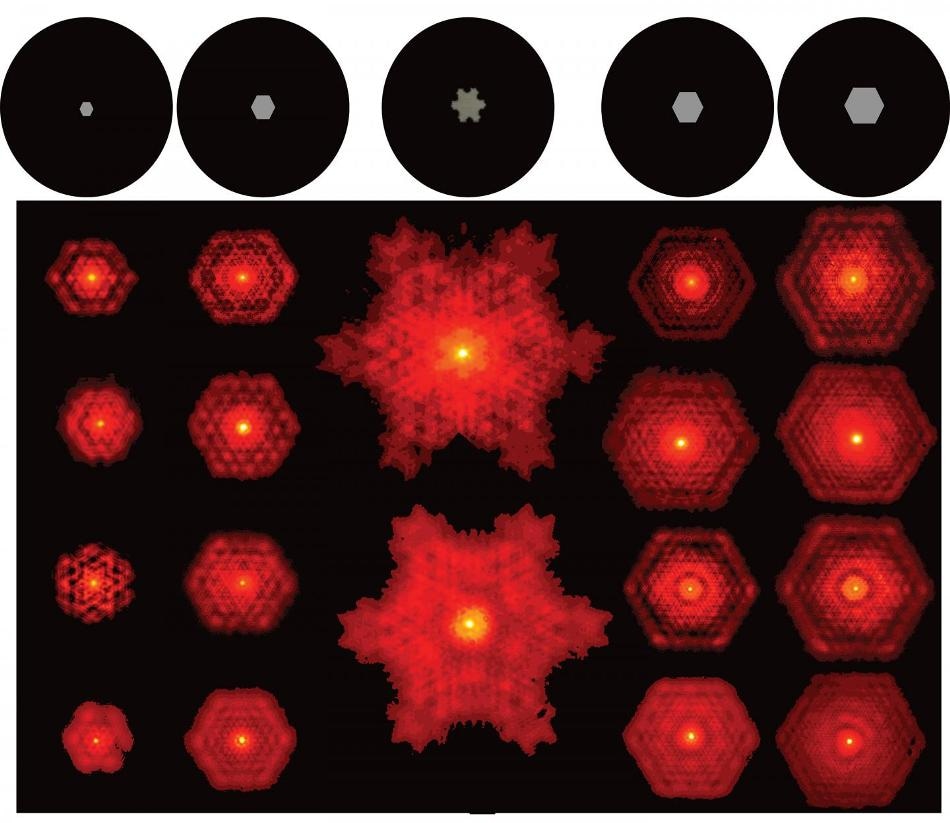Jan 31 2019
People have all observed it before—the exquisitely painted butterfly that emerges when two sheets of paper are spread open, after concealing them with paint and then pushing them together.
 Several patterns of fractal light, created by a laser in the Wits Structured Light Laboratory. (Image credit: Wits University)
Several patterns of fractal light, created by a laser in the Wits Structured Light Laboratory. (Image credit: Wits University)
The creation of a snail’s shell, or the geometrically shaped patterns of a tortoise’s shell; the frost pattern on a car’s windshield after standing outside in winter; or the succulent plant leaves repeating themselves over and over again, to produce a complex pattern. These patterns are all instances of fractals—the nature’s geometry.
As a matter of fact, fractals are the intricate shapes that are seen in nature on a daily basis, and have the characteristic feature of a repeating geometry that has a structure at numerous scales. They are found everywhere—from ferns to Romanesco broccoli, and even as salt flats, clouds, mountains, and coastlines at larger scales. The shape of mountains and trees is self-similar, hence a rocky outcrop looks like a small mountain and a branch that resembles a small tree.
Over the past 20 years, researchers have estimated that fractal light could also be produced from a laser. A laser, with its highly polished circular mirrors, is nearly the exact opposite of nature, and hence it was surprising when light beams discharged from a group of lasers were predicted to be fractals in 1998. Now, a research team from Scotland and South Africa has shown that it is possible to create fractal light from a laser, confirming the prediction of 20 years.
The researchers reported their results in the Physics Review, providing the first experimental proof that fractal light is emitted from simple lasers. They also added a new prediction that the fractal light must exist in 3D and not just in 2D as thought previously.
Fractals are intricate objects that have a “pattern within a pattern”, so that the structure seems to repeat when one zooms in or out of it. Such kinds of “patterns within patterns” are created by nature by several recursions of a basic rule—for instance, to create a snowflake. In addition, computer programs have been utilized to do so by looping through the rule repeatedly, eminently creating the abstract Mandelbrot Set.
This is also done by the light within the lasers—the light cycles back and forth and bounces between the mirrors on every pass, which can be subsequently set for imaging the light into itself on every round trip. This appears just like a recursive loop, repeating a basic rule again and again. The imaging implies that when the light returns to the image plane each time, it is a smaller, or bigger, version of what it was—like a pattern within a pattern within a pattern.
Fractals are used in many applications, for instance, in imaging, antennas, networks, as well as medicine. The researchers believe that the findings of fractal forms of light that can be directly created from a laser should pave the way for new technologies and applications based on these unusual states of structured light.
Fractals is a truly fascinating phenomenon, and is linked to what is known as “Chaos. In the popular science world, Chaos is called the “butterfly effect”, where a small change in one place makes a big change somewhere else, for example, a butterfly beating its wings in Asia causes a hurricane in the USA. This has been proven to be true.
Andrew Forbes, Professor, University of the Witwatersrand
Forbes headed the study along with Professor Johannes Courtial of the University of Glasgow.
When elucidating the discovery of fractal light, Forbes explained that his group came to know the significance of where to search for fractals in a laser. “Look at the wrong place inside the laser and you see just a smeared-out blob of light. Look in the right place, where the imaging happens, and you see fractals.”
The study integrated theoretical know-how from the Glasgow research team with experimental substantiation in South Africa by researchers from University of the Witwatersrand (Wits) and Council for Scientific and Industrial Research (CSIR). Dr Darryl Naidoo (of the CSIR and Wits) developed the initial version of the experiment, which was completed by Hend Sroor (Wits) as part of her PhD.
What is amazing is that, as predicted, the only requirement to demonstrate the effect is a simple laser with two polished spherical mirrors. It was there all the time, just hard to see if you were not looking at the right place.
Johannes Courtial, Professor, University of Glasgow